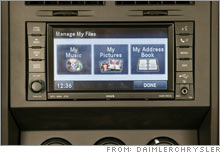Cars: the rolling entertainment hubNew technology allows your car to be your livingroom. Plus, it's got wheels.NEW YORK (CNNMoney.com) -- Minivans and big SUVs are sometimes referred to as "living rooms on wheels." As entertainment technology improves, shrinks and becomes more portable, that expression is becoming more and more literal. Computers and hard drives installed in car dashboards allow for "ripping" and storing MP3s right in the car. There are also new radio options besides the old AM and FM. And, if you really want to feel like you're at home, you can even watch live TV in your car. Rip it
MP3 player connections are becoming common-place in new cars. In most cases, it's just an input jack near the stereo. But in some new models, the car itself can be the MP3 player, allowing you to store your music on an in-car hard-drive. Hard drives were originally added to cars to store complex data for in-car navigation systems. Still, even the most detailed navigation data leaves plenty of left over hard-drive space. So some carmakers are handing that space over to you. The Chrysler Group of DaimlerChrysler (Charts) will offer a feature called MyGig in some of its new cars. Actually, it's about 20 gigabytes. You can use that hard drive space to store music, video and even photographs that can be used as background images on the screen. The new Lexus LS from Toyota (Charts) is also being offered with an on-board hard-drive for storing music. Copyright concerns somewhat limit its usefulness, though. You can only copy songs from original CDs. You can't copy from a home-burned CD and you can't directly copy MP3 files. General Motors' (Charts) soon-to-be-discontinued minivans offer a removable hard-drive system with the unattractive name of PhatNoise. The PhatNoise drive can be removed so you can add music files - and even video and games -easily using your home computer. And there are no restrictions. Unfortunately, PhatNoise isn't offered on any other GM products. Radio of the future Satellite radio, from either Sirius (Charts) or XM (Charts), is an option available from nearly all car manufacturers today. Both offer hundreds of channels of music and talk defined down to the sub-sub-sub-genre. XM Radio, for example offers three slightly different alternative music channels called "Fred," "Ethel" and "Lucy." (No, there is no Latin Alternative channel called "Desi.") A subscription to either service costs about $13 a month. Some carmakers offer a free subscription period when you get satellite radio as an option in your car. Satellite-enabled radios can also be bought as aftermarket items and installed in any car. Some even double as portable satellite radio receivers for use in your home. You don't need satellites and a subscription to get digital radio, though. For now, only BMW offers a high-definition radio receiver as an option in its cars. But you can get an HD radio receiver installed in any car. It costs a little more than a regular car radio, but it's simpler to install than satellite radio. High-definition radio is broadcast over the same radio frequencies as regular radio and by the same stations. But the sound is transmitted as a digital signal that's read out by a computer chip. The main benefit is markedly better sound clarity. Listening to a familiar tune in an HD Radio-equipped BMW 7-series, instruments that couldn't even be heard on a regular FM signal popped right out when the tuner was switched to the digital signal. Also, because the digital signal uses less of the available radio-wave spectrum, broadcasters can send out multiple "side channels." For example, listeners who liked the "oldies" format that New York's WCBS FM used to broadcast - it's now a rock station - can hear the old format again on HD radio. TV enters the car In-car DVD players have been around for some time. It's much cheaper, at a cost of less than $200, to simply buy a portable DVD player and let your kids watch that in the car. In-car DVD systems, which generally cost about $1,000 from the manufacturer, have two main advantages, though. First, they can be controlled by adults riding in the front seats so your kids won't be accidentally shutting it off, resulting in fits. Second, they can't be thrown, dropped or kicked. If you really want the complete living room experience and you've got some cash to spend, you can even get live satellite TV in your car. Using a special satellite dish that lies flat on the roof of the vehicle, a system offered by KVH Industries' (Charts) TracNet, part allows passengers to watch more than 185 channels of DirecTV in the car. It even receives local channels. The same company also offers a separate in-car Internet connection. This doesn't come cheap, of course. The TV system alone costs about $3,000 to install and subscriptions for TV and Internet can cost anywhere from $75 a month to about $140. It's reasonable to wonder why you need live TV in your car, though. Shouldn't there be someplace where you don't have to watch that Head-On ad? Mercedes S65 AMG: Big, fast - and pointless |
|


